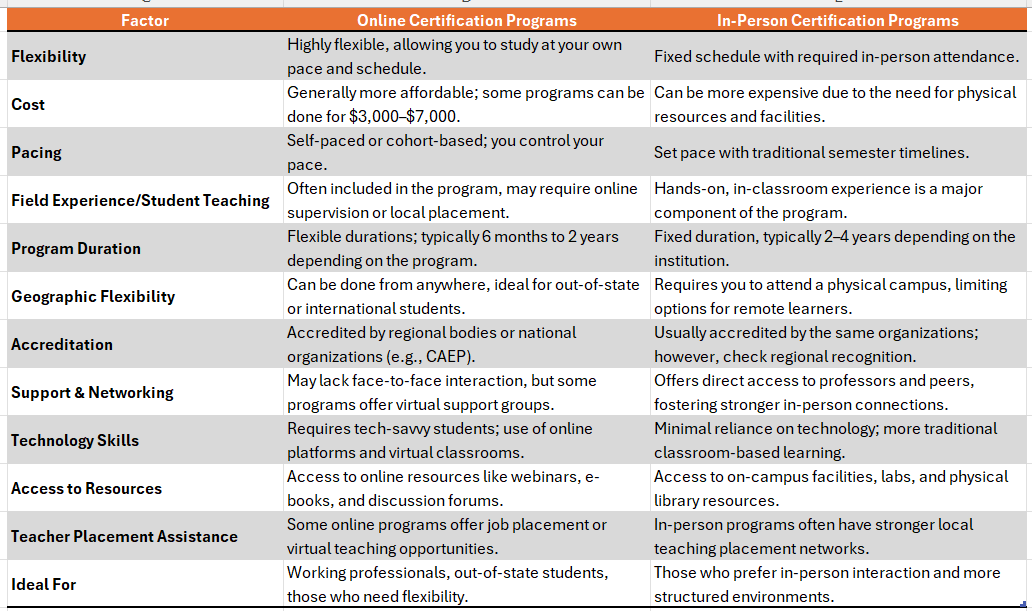
A teaching interventionist is like a classroom superhero, helping students who need extra support to catch up with their peers. These educators provide specialized attention and lessons, ensuring every student has the opportunity to succeed. To become a teaching interventionist certification, obtaining certification is key. This certification opens doors to making a significant impact in students’ lives.
Steps to Get Certified
To earn a teaching interventionist certification, follow these steps:
- Research Requirements: Understand the specific rules in your state.
- Complete Education: Typically, a bachelor’s degree in education or a related field is necessary.
- Gain Experience: Work in teaching or similar roles to build practical skills.
- Pass Exams: Some states require passing specific tests.
- Apply for Certification: Once requirements are met, apply for certification.
Why Certification Matters
Certification demonstrates your skills and knowledge, allowing you to work in schools that need interventionists. It enhances job opportunities and enables you to make a meaningful difference in education.
Study smarter, not harder—Enroll online today!
Why Pursue a Teaching Interventionist Certification?
If you’re passionate about helping students overcome learning challenges, a teaching interventionist certification could be your ideal path. This certification equips educators with specialized skills to support students needing extra help, making you a superhero teacher ready to tackle any learning obstacle. Imagine making a real difference in a student’s life by creating personalized strategies to help them succeed. This role is crucial as it ensures every child has the opportunity to learn and grow, regardless of their starting point. Plus, it opens doors to exciting career opportunities in education!
Benefits of Becoming a Teaching Interventionist
- Impactful Role: Directly influence students’ academic journeys.
- Career Advancement: Access specialized roles and potentially higher salaries.
- Skill Development: Gain expertise in innovative teaching methods.
Steps to Get Certified
- Research Programs: Find accredited programs.
- Meet Requirements: Fulfill prerequisites like a teaching degree.
- Complete Coursework: Learn intervention strategies.
- Pass Exams: Prove your knowledge.
- Apply Your Skills: Make a difference in classrooms!
Essential Qualifications for Aspiring Teaching Interventionists
Becoming a teaching interventionist is a rewarding journey that allows you to make a significant impact on students who need extra help. But how do you get a teaching interventionist certification? Understanding the essential qualifications is the first step to embarking on this fulfilling career path.
1. Educational Background
To start, you’ll need a solid educational foundation. Most teaching interventionist certification programs require at least a bachelor’s degree in education or a related field. This ensures you have the necessary knowledge and skills to support diverse learning needs effectively.
2. Specialized Training
Next, specialized training is crucial. Look for programs that offer courses in special education, literacy intervention, or behavior management. These courses equip you with the strategies needed to address various student challenges.
3. Certification Process
Finally, the certification process itself involves passing specific exams and completing practical teaching hours. This hands-on experience is vital as it prepares you for real-world classroom scenarios, ensuring you’re ready to make a difference from day one.
Step-by-Step Guide to Earning Your Teaching Interventionist Certification
Embarking on the path to obtaining a teaching interventionist certification is a fulfilling endeavor that equips educators to assist students requiring additional support. This certification is vital for those aiming to specialize in targeted educational assistance. Here’s a streamlined guide to help you through the process:
1. Understand the Role: Teaching interventionists collaborate closely with students, identifying and addressing learning challenges. This role demands patience, creativity, and a genuine passion for teaching.
2. Meet the Prerequisites: Typically, a bachelor’s degree in education or a related field is necessary. Some programs may also require prior teaching experience, alongside strong communication and problem-solving skills.
3. Choose the Right Program: Explore various certification programs, considering factors like duration, cost, and curriculum. Online options can offer flexibility for those balancing work and study.
4. Complete the Coursework: Engage in coursework covering instructional strategies and intervention methods. Staying organized and seeking instructor support is crucial.
5. Pass the Certification Exam: Prepare thoroughly for the certification exam by reviewing materials and taking practice tests. Successfully passing this exam is essential for certification.
What to Expect in a Teaching Interventionist Certification Program
Earning a teaching interventionist certification is like unlocking a special key to help students who need extra support. This certification equips you with the skills to make a real difference in students’ lives, especially those who learn differently or face challenges in the classroom.
Program Overview
Expect a blend of coursework and practical experience, including classes on child psychology, special education laws, and instructional methods for diverse learners. You’ll learn various teaching strategies and how to apply them effectively.
Hands-On Experience
A significant part of the program involves hands-on experience through supervised teaching sessions, allowing you to practice and gain confidence in supporting students effectively.
Key Skills Developed
- Communication: Learn to communicate effectively with students, parents, and educators.
- Problem-Solving: Develop strategies to address learning challenges.
- Adaptability: Adjust teaching methods to meet individual student needs.
By the end of the program, you’ll be well-prepared to step into a classroom and make a positive impact as a teaching interventionist.
Navigating the Application Process for Certification
Becoming a teaching interventionist is a rewarding journey, allowing you to support students in overcoming learning challenges. To start, research your state’s specific requirements for teaching interventionist certification, as they vary. Check your state’s education department website for details on necessary degrees, exams, and experience.
Next, gather essential documents like proof of educational qualifications, transcripts, and any existing teaching licenses. Many states also require specific coursework, so consider enrolling in online courses or workshops focused on intervention strategies.
Once prepared, apply for certification by filling out the application form on your state’s education department website. Ensure all information is accurate to avoid delays. Additionally, some states require passing an exam, so utilize study guides and practice tests to prepare effectively.
By following these steps, you’ll be on your way to becoming a certified teaching interventionist, ready to make a positive impact in the classroom. Good luck on your journey!
Online vs. In-Person Certification Programs: Which is Right for You?

Getting a teaching interventionist certification is a gateway to a fulfilling career helping students with learning challenges. Choosing the right certification path can be daunting, but understanding your options can make the decision easier.
Online programs offer flexibility, allowing you to learn at your own pace, which is ideal if you have other commitments like work or family. You can access materials from anywhere, making it convenient. In contrast, in-person programs provide a traditional classroom setting with face-to-face interaction, beneficial for hands-on learning and immediate feedback.
Consider these factors when deciding:
- Learning Style: Do you prefer self-paced or structured learning?
- Schedule: Are you available for set class times, or do you need flexibility?
- Interaction: Do you value in-person networking and collaboration?
Ultimately, the choice between online and in-person teaching interventionist certification programs depends on your lifestyle and preferences. Weigh the pros and cons to make a decision that aligns with your goals.
Study smarter, not harder—Enroll online today!
How Scholarship.Education Supports Your Journey to Certification
Earning a teaching interventionist certification is a rewarding way to support students who need extra help. But how do you begin this impactful journey? That’s where Scholarship.Education steps in to assist you at every stage.
Step-by-Step Guidance
- Research Requirements: Each state has unique certification criteria. Scholarship.Education offers a detailed guide to help you understand the specific requirements in your area.
- Find the Right Program: Not all programs are the same. Scholarship.Education allows you to compare various teaching interventionist programs to find the best fit for you.
Resources and Support
- Study Materials: Access extensive study resources and practice tests to prepare effectively for your certification exams.
- Community Support: Engage with forums and groups on Scholarship.Education to connect with peers, exchange tips, and gain motivation.
With Scholarship.Education guiding you, the journey to becoming a certified teaching interventionist is straightforward and attainable. Begin today and make a significant difference in students’ lives!
Common Challenges in Certification and How to Overcome Them
Pursuing a teaching interventionist certification is rewarding but presents challenges. Balancing work and study can be tough, so it’s crucial to create a realistic schedule using planners or digital calendars to manage both effectively. The coursework can be complex, and if you struggle with certain topics, joining study groups or online forums can provide valuable support and guidance from peers and mentors. Financial constraints are another hurdle, but exploring scholarships, grants, or payment plans can ease the burden. Some employers might even offer tuition reimbursement for professional development courses. By identifying these challenges and adopting strategies to tackle them, you can successfully achieve your certification and make a meaningful impact in the classroom.
Exploring Career Opportunities with a Teaching Interventionist Certification
A teaching interventionist certification is your gateway to a fulfilling career where you can significantly impact students’ lives by providing the support they need to overcome learning challenges. This certification not only enhances your teaching skills but also opens up diverse opportunities across various educational settings, from elementary schools to specialized programs.
Why Pursue a Teaching Interventionist Certification?
- Impactful Role: Help students succeed by overcoming learning obstacles.
- Diverse Opportunities: Work in different educational environments.
- Professional Growth: Advance your career with new skills.
Steps to Get Certified
- Research Requirements: Understand state-specific criteria.
- Enroll in a Program: Choose a suitable certification course.
- Complete Coursework: Learn effective student support strategies.
- Pass the Exam: Validate your skills and knowledge.
Benefits of Certification
- Increased Job Opportunities: Schools seek qualified interventionists.
- Higher Earning Potential: Certification can boost your salary.
- Job Satisfaction: Experience the joy of helping students thrive.
Embarking on this certification journey not only enhances your career but also allows you to make a meaningful difference in education.
Study smarter, not harder—Enroll online today!
FAQs
1. What is a teaching interventionist?
A teaching interventionist is an educator who works with students who need additional academic support, often in reading, math, or behavior. They design and implement interventions to help students catch up or stay on track.
2. Do interventionists need to be certified teachers?
Yes, most states require interventionists to hold a valid teaching license. Some positions also require additional certification or endorsements in special education, reading, or a specific intervention area.
3. What certifications are typically required?
Requirements vary by state, but many interventionist roles prefer or require certifications such as:
-
Reading Specialist Endorsement
-
Special Education Certification
-
Response to Intervention (RTI) or MTSS training
4. Can a general education teacher become an interventionist?
Yes, general education teachers can become interventionists by gaining relevant experience and, in some cases, completing additional coursework or earning an endorsement.
5. Is interventionist certification the same in every state?
No, certification requirements vary by state. Some have specific endorsements or titles (e.g., Academic Interventionist), while others include intervention roles under broader special education or instructional support certifications.
6. What skills or training are important for interventionists?
Training in data-driven instruction, progress monitoring, differentiated instruction, and MTSS/RTI frameworks is valuable. Some states may require formal coursework or professional development in these areas.





